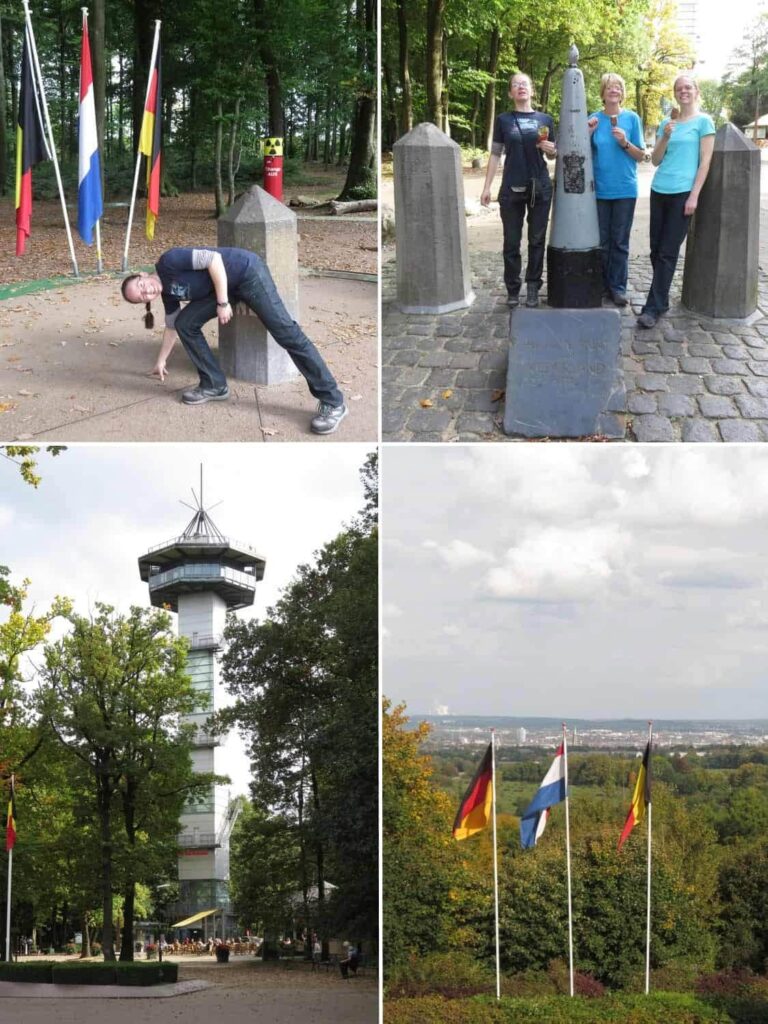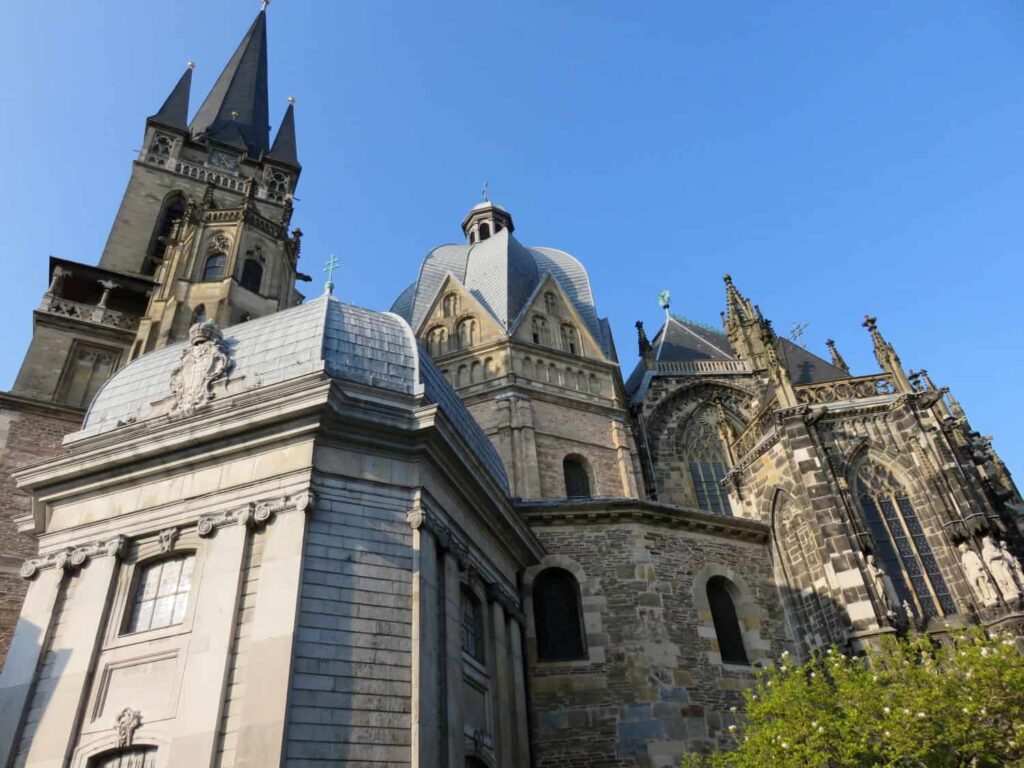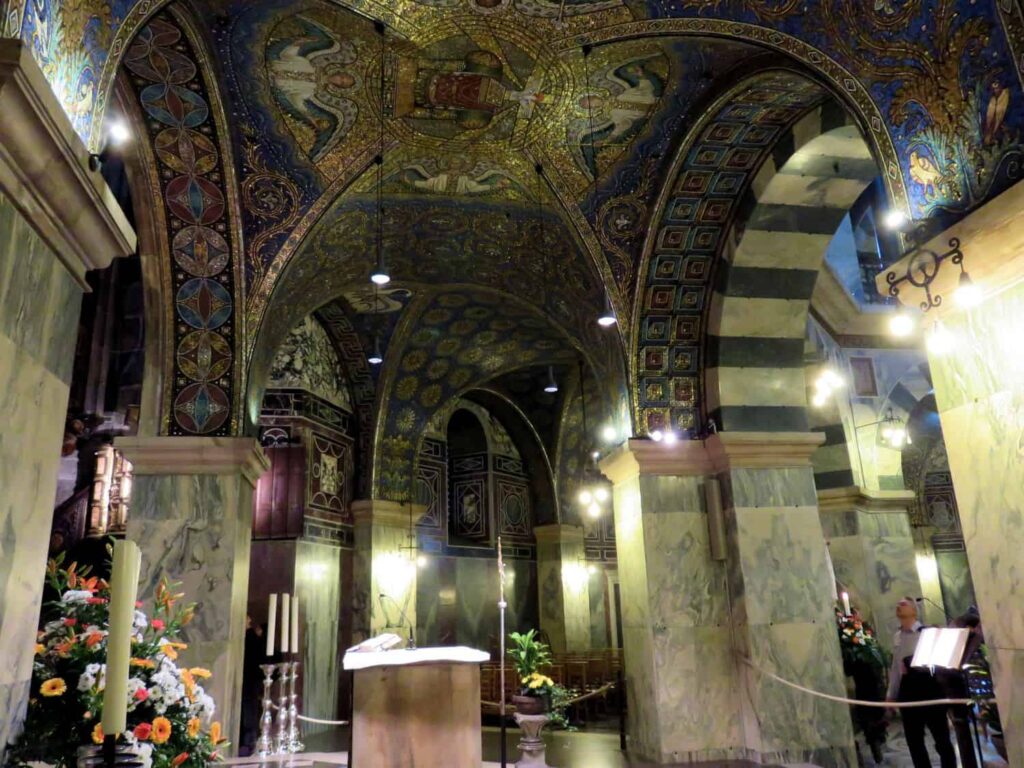Aachen is a spa town in West Germany bordering the Netherlands and Belgium that was Charlemagne’s favourite town and his final resting place.
The main attraction is the Kaiserdom (Imperial Cathedral). Its interior is so amazing that no picture does it justice; it must be seen to be believed.
On our trip there, we found a field on the edge of a forest area that looked like a great base from which to explore and an ideal place to spend the night. It was about 4.5km out of town and 1.5km from Drielanderpunt (three land point) which we also wanted to visit. Drielanderpunt is where the borders of the Netherlands, Germany, and Belgium meet. It has become an attraction with a maze and two viewing towers.

In 1920 it was actually the meeting place of 4 countries, called a quadripoint, which is very rare. The road to the site on the Netherlands side is still called Viergrenzeweg (four border way) while the other countries roads refer to three borders.
The area boasts viewing towers, a Labyrinth, shooting activities and a restaurant.

This means you can physically be in three countries at the same time. This is the place where all three borders meet with Candice demonstrating the concept.
We enjoyed ice cream, with Candice trying to make up her height deficit, at the highest point in the Netherlands which at 322,4 meters (1,056 feet) above sea level. This is relatively low compared to other countries but something for the 4th flattest country in the world with approximately 26% of the country’s land area below sea level, and 60% less than 1 meter (3.3 feet) above sea level.
Compare this to the highest place in the world which is Mount Everest which reaches an incredible 8,848.86 meters (29,031.7 feet) above sea level.
The bottom left picture above is the viewing tower in Belgium and next to it the view past country flags to a view of Aachen, the next stop on our journey.

We then cycled back past our motorhome into Aachen which was the preferred residence of Charlemagne, King of the Franks and Holy Roman Emperor. He built his palace and church here, which became a center of learning and culture.
This picture is an aerial view highlighting the main attractions of Aachen. The Imperial Cathedral in the foreground and the Town Hall in the background.

We had read about the famous Aachener Printen. So we ventured into this bakery and we discovered a delicious treat which is similar to gingerbread but with its own unique taste. Our advance reading fell well short of describing how good it was.
It originates from Aachen where the secret recipe has been passed on from generation to generation and the recipe remains a secret to this day! It is produced with dark flour, three dark sugars and exotic spices.
We purchased a large amount and even returned the next day to purchase more. It was savored and treasured in our house for many months after the trip.

The magnificent Aachen Cathedral has an imposing and varied exterior that is difficult to photograph from the narrow surrounding streets. The Aachen Dom (Cathedral) was built by Charlemagne in 805 AD when he made Aachen the center of his Holy Roman empire.
The cathedral is one of the oldest and most impressive in Europe. It is far from the biggest cathedral but definitely has a distinctive royal character and feel. Not surprising then that it was the first choice for the coronation of thirty-one German kings and twelve queens for over 600 years including Charlemagne himself.

The interior in unbelievable! Pictures do not do it any justice. The massive center piece is a wheel chandelier that hangs on a long chain, with a diameter of over four meters it is known as the Barbarossa Chandelier. The forty-eight candles are lit for special occasions, which would be a treat to see. It was a donation from Emperor Frederick Barbarossa, who was crowned as King of Germany in this cathedral in 1152.

The intricate designs, shapes and curves all compete for your attention and the more time you spend looking the more you are amazed. The Interior is not done any justice by pictures.
The intricate, detailed and colourful mosaic designs are perfectly integrated with amazing marble which must be seen to be appreciated.

The detailed and colorful mosaic designs are perfectly integrated with marble that is an amazing assault on the eyes and mind. It must be seen to be believed. Close-ups of some sections highlighting the amazing detail and colour of the mosaic and marble. It is hard to imagine the time, patience and perseverance that was poured out in this place

If all that was not enough the Cathedral also features a stunning array of huge stained-glass windows which compete with everything else for you attention.
In the bottom center is The Karlsschrein (Shrine of Charlemagne) which contains the remains of Charlemagne.

Setting up the camera for a group picture with the rear of the Aachener Rathaus (town hall) in view, which is one of the other main attractions in Aachen. This is the southern and rear side of the Rathaus.
Our bicycles, particularly Ann’s one, was very useful as a portable stand for the camera.

The group picture achieved with the varied Aachen Cathedral exterior towering in the background. We are in the Katschhof which was the inner courtyard of Charlemagne’s palace and the square between the Königshalle (today Aachen City Hall) and St. Mary’s Church (today Aachen Cathedral). This popular town square is a place where flea markets, concerts and festivals are held, including the renowned Christmas Market which attracts people from far and wide.

We stopped to eat pastries at The Charlemagne fountain in the Aachen Marktplatz (marketplace)which is in front of the Rathaus. We were entertained by the festivities of a bachelorette party. She arrived in a male-drawn cart and had to perform a whole lot of challenges and activities.
Tradition dictates that Charlemagne must be kissed so she had to climb to the top of the fountain, with much lifting and pushing from her companions. The eventual kiss resulted in much celebration.

Aachen is a spa town with a number of hot springs and thermal baths which were used by the Romans and Charlemagne himself. So there are fountains everywhere. This fountain is called ‘Der Hühnerdieb’ (the chicken thief) a statue of an individual who stole a rooster instead of a chicken and was caught because of the rooster’s cry. He then had to face the whole towns ridicule!

Aachen has a long tradition of puppetry, with the oldest puppet theater in Germany, founded in 1947. The theater still performs classic fairy tales and modern stories. So another very interesting fountain is the Puppenbrunnen (puppet fountain) which has become an iconic symbol of Aachen, reflecting the city’s playful and artistic side.
It invites you to interact with its many moving parts and the puppets depict various Aachen-themed characters, including: Charlemagne, a knight, a noblewoman, a jester and a musician
The rooster on top is said to be either a symbol of Napoleon’s love for Aachen or the time of French occupation and apparently also the cleverness of the towns inhabitants. The tower of the Rathaus is in the background.
Add Aachen to your own Google Map – Places to Visit – Wish List. Watch this video to find out how.
For more detailed information about what to see in Aachen read this PlanetWare article.
For information about visiting the amazing Aachen Cathedral check out their official website.







